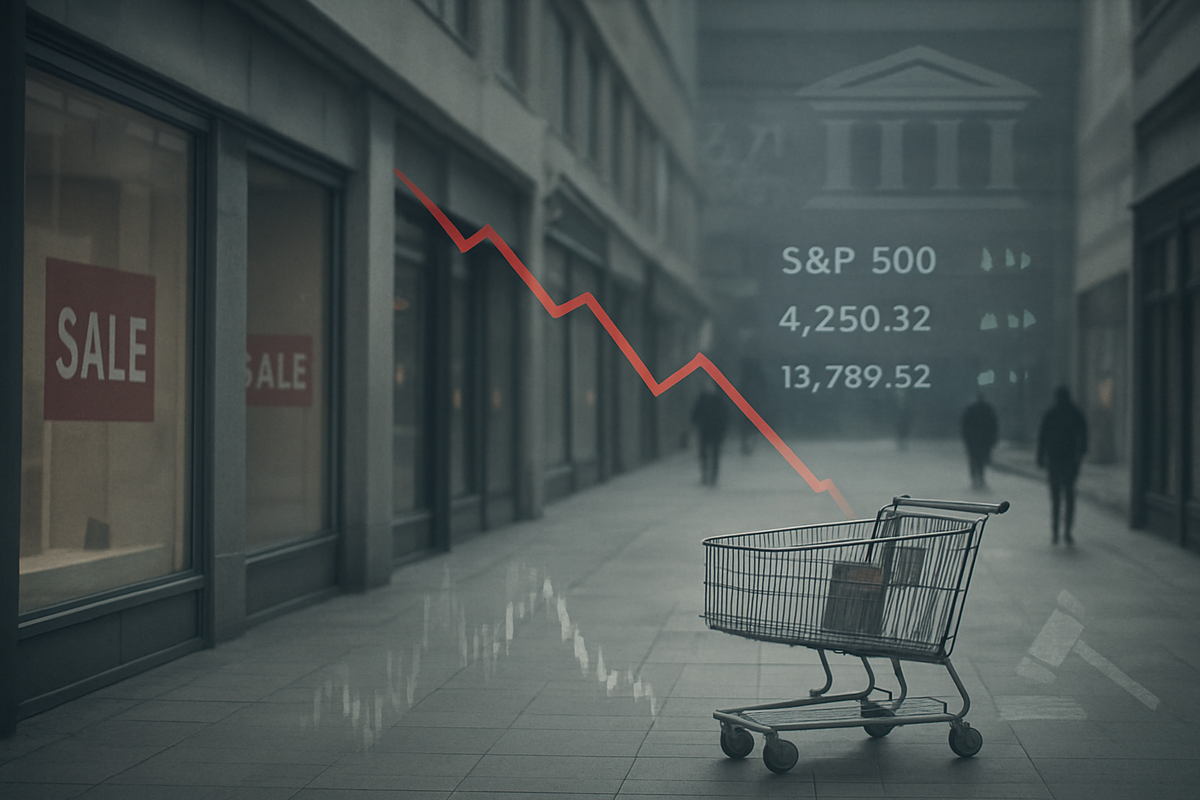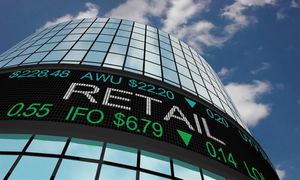
November 25, 2025 – The highly anticipated, albeit significantly delayed, September 2025 retail sales report has finally landed, painting a picture of moderating consumer spending that sent a ripple of caution through financial markets. Released today, November 25, 2025, after a protracted 43-day government shutdown, the data revealed a weaker-than-expected performance, prompting analysts to reassess the trajectory of consumer health and its implications for the broader economy. While the immediate market reaction was somewhat muted given the report's dated nature, the underlying message of softening demand has undoubtedly played a role in moderating the recent robust performance of indices like the S&P 500 and Nasdaq, even as it simultaneously fueled expectations for a December interest rate cut by the Federal Reserve.
The report's findings underscore a growing divergence in consumer resilience and add a layer of complexity to the economic outlook as the crucial holiday shopping season approaches. Despite earlier optimism spurred by strong economic data, the September retail figures suggest that the tailwinds supporting consumer spending might be losing some of their force, creating a nuanced environment where the promise of monetary easing contends with concerns about sustained economic momentum.
Delayed Data Reveals Decelerating Consumer Spending
The September 2025 retail sales report indicated a significant deceleration in consumer spending momentum, falling short of market expectations across key metrics. Overall, US retail sales edged up by a mere 0.2% month-over-month, reaching $733.3 billion. This figure starkly missed the anticipated 0.4% rise and marked the smallest monthly gain in four months, following a more robust 0.6% increase in August. Even when excluding the volatile motor vehicle and parts segment, core retail sales saw a modest 0.3% month-over-month increase, again below the 0.4% consensus and a slowdown from August's pace. Further stripping out gasoline sales, the increase was a negligible 0.1%. On an annual basis, total retail sales in September were up 4.3% from September 2024, with the broader July-September 2025 quarter showing a 4.5% year-over-year increase.
A closer look at the sectoral breakdown reveals a mixed bag. Some categories demonstrated resilience, including miscellaneous store retailers (up 2.9% month-over-month), gasoline stations (up 2.0%), health & personal care stores (up 1.1%), and food services and drinking places (up 0.7%). Food services, in particular, boasted a strong 6.7% year-over-year increase. Conversely, discretionary sectors experienced notable declines, with sporting goods, hobby, musical instruments, and book stores witnessing a 2.5% drop. Department store sales fell 0.7%, and clothing and clothing accessories stores dipped 0.7%. Nonstore retailers' sales, often a bellwether for e-commerce, also saw a 0.7% month-over-month dip, though they maintained a healthy 6.0% year-over-year growth.
The market's immediate reaction to the report today, November 25, 2025, was largely muted, a direct consequence of the data being considered "stale" or "old news" due to the significant delay caused by the government shutdown. US stock futures, including those for the S&P 500 and Nasdaq 100, experienced a slight dip, down 0.2% and 0.3% respectively, with the broader indices poised for a mixed opening. The US Dollar (USD) remained under pressure, while Treasury yields held steady. Many analysts suggested that investors were primarily looking ahead to more current economic indicators, having already priced in some degree of consumer slowdown.
Despite the initial muted response to the dated figures, the report's underlying implications for consumer health and monetary policy significantly influenced market sentiment. The softer-than-expected retail sales data, coupled with a core Producer Price Index (PPI) also falling short of expectations, reinforced "dovish" implications, substantially increasing the likelihood of a Federal Reserve interest rate cut in December. The CME Group's FedWatch Tool showed an 84.9% probability of a quarter-point rate reduction, a substantial jump from 42.4% just a week prior. This heightened expectation of monetary easing acted as a strong underlying current, propelling broader market optimism and, at times, volatility. Prior to this delayed report, the S&P 500 and Nasdaq had actually recorded their strongest September in 15 years, fueled by the Federal Reserve's initial rate cut in its cycle, moderating inflation, and robust Q2 2025 GDP growth of 3.8%. However, the September retail sales data introduced new concerns about sustained consumer strength as the crucial holiday shopping season approaches, with some analysts expressing concerns that the year's AI-fueled rally might be entering "bubble territory" amidst the lack of up-to-date economic visibility.
Companies Navigate Shifting Consumer Tides: Winners and Losers Emerge
The moderation in September retail sales, particularly in discretionary categories, is poised to create a distinct landscape of winners and losers among public companies, forcing strategic reevaluations across various sectors. As consumers tighten their belts and prioritize value, businesses catering to essential needs and affordability are expected to show greater resilience, while those reliant on non-essential spending face increasing headwinds.
On the losing side, the Consumer Discretionary Sector is bracing for significant pressure. Companies selling non-essential goods and services, such as apparel, electronics, home furnishings, and restaurants, are highly vulnerable to reduced consumer spending. Automakers like Tesla (NASDAQ: TSLA), General Motors (NYSE: GM), and Ford (NYSE: F) have already shown signs of struggling with demand and affordability issues, and a further slowdown in spending could exacerbate these challenges. Appliance manufacturers such as Whirlpool (NYSE: WHR) could also see demand wane. Companies like Bath & Body Works (NYSE: BBWI) have previously seen their stock plummet after disappointing results, illustrating the sector's inherent vulnerability. These companies are likely to experience compressing operating margins, prompting strategies focused on cost-cutting, inventory management, and aggressive promotions to attract cautious buyers.
The Luxury Goods sector is another clear casualty. Brands like Burberry (LSE: BRBY), Hugo Boss (ETR: BOSS), Mulberry (LSE: MUL), LVMH (EPA: MC), Kering (EPA: KER) (owner of Gucci, Balenciaga, and Saint Laurent), and Richemont (SWX: CFR) (owner of Cartier) have already reported declining sales or issued profit warnings in recent times. This report is likely to intensify those pressures, as luxury purchases are among the first to be cut during economic uncertainty. The sector's pricing power has eroded, and a global generational shift, coupled with a shrinking middle class, suggests a need for fundamental rethinking of brand strategies, potentially focusing on "small indulgences" or leveraging outlet channels for perceived value.
The impact on E-commerce is expected to be mixed. While online retail continues its long-term growth trajectory due to convenience and flexibility, platforms primarily selling discretionary items will still feel the pinch of reduced demand. Diversified giants like Amazon (NASDAQ: AMZN), while robust, could face "added scrutiny" on their outlook during challenging macroeconomic backdrops. However, e-commerce's agility and data-driven insights, coupled with strong omnichannel strategies that seamlessly integrate online and in-store experiences, could provide a competitive advantage as consumers become more price-sensitive and seek out the best deals.
Conversely, the Consumer Staples Sector is poised for greater resilience, often acting as a "safe haven" during economic uncertainty. Companies providing essential goods like food, beverages, and household products typically see stable demand regardless of economic fluctuations. Retail behemoth Walmart (NYSE: WMT), which spans both staples and discount categories, has demonstrated strong performance, gaining market share in grocery, health, wellness, and general merchandise, indicating a broader consumer shift towards value. Even within staples, however, premium product segments might see consumers "trading down" to more affordable options, prompting companies to focus on cost reduction, supply chain optimization, and transparent pricing.
Discount Retailers are also well-positioned to thrive in this environment. As consumers become increasingly budget-conscious, stores like TJX Companies (NYSE: TJX) (operating TJ Maxx, HomeGoods, and Marshalls), Ross Stores (NASDAQ: ROST), and Burlington Stores (NYSE: BURL) are likely to attract increased traffic from shoppers trading down from higher-priced establishments. These retailers excel at offering perceived value through their "treasure-hunt" shopping experiences. While not entirely immune to challenges like inflation eating into thin margins, their core strategy of competitive pricing and careful inventory management positions them favorably against broader market disappointments.
Wider Significance: A Bellwether for Broader Economic Trends and Fed Policy
The disappointing September retail sales report, released today on November 25, 2025, extends far beyond the immediate performance of retail stocks; it acts as a critical bellwether for broader economic trends, with profound implications for inflation, interest rates, and the Federal Reserve's monetary policy. This data point, though delayed, reinforces existing forecasts of a weakening U.S. consumer and signals a crucial inflection point for the economy.
In terms of broader economic trends, the report unequivocally points to a significant pullback in consumer spending, a cornerstone of economic activity. This aligns with projections for a slowdown in year-over-year nominal spending growth throughout late 2025 and into 2026. Consumers are increasingly cautious, prioritizing value, extending their research into purchases, and increasing their savings. Notably, lower and middle-income households are showing the most visible signs of reduced spending, contributing to a decline in consumer confidence observed in November 2025 amidst concerns over high costs and sluggish job gains. While nominal sales might still show growth due to persistent inflation, the actual volume of goods sold could be contracting, indicating a deeper underlying weakness.
Regarding inflation, weaker retail sales inherently suggest a moderation in demand, which could contribute to alleviating demand-driven inflationary pressures. However, the current economic tableau of late 2025 remains complex. While inflation has receded from its peaks, core inflation is still anticipated to hover near 3% year-over-year. Furthermore, the specter of new tariffs could introduce supply-side inflationary pressures, potentially elevating the core Personal Consumption Expenditures (PCE) price index. Thus, while soft retail sales might offer a disinflationary impulse from the demand side, other factors could keep overall price levels elevated.
For interest rates, a disappointing retail sales report typically bolsters market expectations for Federal Reserve interest rate cuts. Weaker economic data, particularly signs of slowing consumer spending and a fragile labor market, would likely compel the Fed to adopt a more "dovish" stance, prioritizing economic growth and job preservation over solely focusing on inflation. Historically, lower retail sales figures and a contracting economy have often led to a decrease in inflation, which can cause investors to gravitate towards bonds and signal that the Fed will lower rates. Indeed, market expectations in late 2025 already anticipate aggressive Fed rate cuts, with some analysts suggesting an initial reduction may have occurred in September 2025, and further easing expected. Conversely, the high interest rates already in place have restricted credit availability and contributed to the observed reduction in consumer spending, discouraging borrowing for major purchases and incentivizing saving.
The ripple effects of a retail slowdown are extensive, touching numerous other sectors. Manufacturing and Production directly feel the impact of reduced consumer demand, leading to fewer orders and potential production cuts. The manufacturing sector is particularly sensitive, as demand drops can have magnified negative effects on employment. While the Services Sector might be less impacted than durable goods, a broader economic slowdown indicated by weak retail sales could eventually dampen service sector activity as well. Consequently, Employment across various sectors, especially retail and manufacturing, could see hiring freezes or layoffs as companies scramble to cut costs. This exacerbates existing concerns about a weakening labor market. Ultimately, disappointing sales directly impact Corporate Earnings and Stock Market valuations, particularly for consumer-facing companies. The Real Estate sector, already grappling with high mortgage rates, could also face further challenges as consumer confidence wanes and affordability becomes an even greater hurdle.
For the Federal Reserve, this report presents a delicate policy dilemma. Signs of weakening consumer spending and a softening labor market would likely intensify bets on interest rate cuts, pushing the Fed towards a more accommodative monetary policy. The Fed's primary tool would be adjusting the federal funds rate, making borrowing cheaper to stimulate spending and investment. However, the recent government shutdowns have delayed the release of crucial economic data, making it more challenging for the Fed to make fully informed decisions and potentially leading them to rely more on private sector data. The central bank faces a balancing act: while weak retail sales argue for easing, persistent inflation (potentially fueled by tariffs) counsels caution.
Historically, weak retail sales have often served as precursors to significant economic shifts and Fed policy changes. Such data, when combined with other weak indicators like manufacturing activity and consumer sentiment, has consistently aligned with expectations for slower economic growth and heightened recession risks. In response to disinflationary pressures or a weakening economy, central banks have historically cut interest rates to stimulate activity, as seen when central banks in advanced economies began cutting rates in summer 2024 after inflation approached target levels. Consumer behavior during periods of economic uncertainty has also consistently shown a trend of cutting back, seeking discounts, and prioritizing value, mirroring the trends observed and anticipated in 2025, with the rise of "Buy Now, Pay Later" services reflecting consumers' need for greater financial flexibility.
What Comes Next: Navigating a Period of Economic Uncertainty
The implications of a disappointing September retail sales report, unfolding against a backdrop of persistent inflation, a cautious labor market, and policy uncertainties, set the stage for a period of careful navigation for businesses and investors alike. As of November 25, 2025, both the short-term and long-term outlooks point to an evolving economic landscape demanding agility and strategic foresight.
In the short-term (Q4 2025 - Q1 2026), a sustained slowdown in consumer spending is highly probable. Economists anticipate a further deceleration in the final quarter of 2025, exacerbated by the lingering effects of the government shutdown, subdued hiring, and elevated inflation. This suggests a potentially more conservative holiday shopping season than initially hoped. The U.S. economy, while showing solid growth in Q3, remains in an uncertain state, with weak job creation and a rising unemployment rate (reaching 4.4% in September, a four-year high) posing risks to broader economic activity. This mixed performance, however, increases the likelihood of the Federal Reserve considering interest rate cuts in the near term, especially if core inflation continues to cool, despite the added complexity of wholesale price increases from energy costs. Divergent spending patterns will persist, with higher-income consumers continuing to drive discretionary purchases, while lower and middle-income households increasingly prioritize value and necessities.
Looking to the long-term (2026 and beyond), a moderated pace of retail and economic growth appears to be the most likely scenario. The National Retail Federation (NRF) forecasts a slower retail sales growth of 2.7% to 3.7% for 2025, with overall GDP growth expected to dip slightly below 2%. Lingering inflation, though interest rates are anticipated to ease to around 2.75% by the end of 2025, and anxieties over tariffs will contribute to this moderation. Consumers are expected to remain cautious, value-oriented, and more deliberate in their purchasing decisions, moving away from impulse buys. Concurrently, e-commerce is projected to continue its robust growth (7-9% year-over-year increase in 2025), alongside a growing consumer preference for experiences over physical goods, particularly in areas like travel and dining. The increasing demand for sustainable products and brands aligning with consumer values, with many willing to pay a premium for eco-friendly options, also represents a significant long-term trend. Furthermore, Artificial Intelligence (AI) is poised for deep integration into retail operations, from personalized recommendations and customer service to demand forecasting and inventory management, promising enhanced efficiency and improved conversion rates.
In response, strategic pivots and adaptations for businesses are critical. Retailers must re-emphasize value and affordability, clearly communicating competitive pricing and adjusting product assortments to include more affordable or essential items. Significant investment in technology and digital transformation, particularly AI and automation, will be crucial for enhancing customer experiences, optimizing operational efficiencies, and improving supply chain management. Modernizing supply chains for greater resilience, efficiency, and transparency (e.g., using RFID) is also paramount. Businesses must also redouble efforts on customer loyalty and experience, creating seamless journeys across all touchpoints. Adapting to evolving consumer preferences, such as the demand for experiences and sustainable products, and addressing workforce challenges through automation and training, will be key. Finally, embracing flexible payment options like "Buy Now, Pay Later" (BNPL) can cater to shifting consumer financial habits.
These dynamics present both market opportunities and challenges. Opportunities lie in the continued expansion of e-commerce, the adoption of advanced technologies like AI, catering to value-oriented segments, and tapping into experiential and sustainable markets. However, businesses will face intensified competition, rising operational costs (wages, energy, supply chain), persistent supply chain vulnerabilities due to geopolitical tensions, consumer sentiment volatility, and growing cybersecurity threats.
Considering these factors, several potential scenarios and outcomes for the economy and markets emerge. The base case anticipates slow but steady growth with caution: continued economic momentum with GDP moderating, cautious consumer spending, and potential Federal Reserve interest rate cuts by year-end 2025. Markets might experience moderate gains, with technology and value retailers potentially outperforming. A downside scenario could see an economic slowdown or mild recession if weak hiring persists, unemployment rises significantly, and consumer confidence plummets, exacerbated by escalating tariffs. This would lead to increased market volatility and declines, with defensive stocks showing greater resilience, and central banks potentially implementing more aggressive rate cuts alongside government stimulus. Conversely, an upside scenario could involve a resilient consumer-led recovery, fueled by a stronger-than-expected rebound in confidence, clearer signs of cooling inflation, significant wage growth, and decisive interest rate cuts. This would lead to accelerated consumer spending, lifting GDP growth, and a positive market reaction with broader gains across sectors. The coming months will be pivotal in determining which of these paths the economy ultimately takes.
Wrap-Up: A Cautious Market Pivots on Fed Expectations
The September 2025 retail sales report, though delayed by a government shutdown and released today, November 25, 2025, serves as a crucial economic barometer, solidifying a narrative of moderating consumer spending that will significantly shape market sentiment and Federal Reserve policy in the coming months. Its key takeaway is a modest 0.2% month-over-month increase in sales, falling short of expectations and marking a clear deceleration from prior months. This weakness, particularly in core retail sales and unit volumes, underscores a reduction in consumer purchasing power, driven by persistent inflation and growing financial strain among lower and middle-income households, contrasting sharply with the more robust spending patterns of higher-income consumers.
The market's initial reaction was a fleeting moment of mixed to slightly negative sentiment, quickly overshadowed by a surge in optimism regarding potential interest rate cuts by the Federal Reserve. Futures markets are now pricing in an overwhelming 83-85% probability of a 25-basis-point rate reduction at the Fed's upcoming December meeting, heavily influenced by increasingly dovish statements from central bank officials. The weaker retail sales, coupled with other mixed economic indicators like a rise in the Producer Price Index (PPI) and an uptick in the unemployment rate to a four-year high of 4.4% in September, have collectively reinforced this "growth-cooling narrative," making rate cuts appear almost inevitable. Consequently, the US Dollar Index has softened, Treasury yields have eased, and gold has found support. Despite some volatility, particularly a rebound in AI and growth-oriented technology stocks after recent losses, the broader stock market's response to the September figures was largely muted, as the data was largely considered "old news" by a forward-looking market that had already priced in much of the observed weakness and the anticipation of monetary easing.
Moving forward, the market is assessing a complex economic landscape. While the July-September quarter is still expected to show solid GDP growth, the September slowdown, alongside weak hiring and a rising unemployment rate, poses a clear risk to sustained consumer spending and the broader economy if these trends persist. The widening gap in spending power between higher- and lower-income households remains a critical underlying theme. The prevailing sentiment among economists leans towards a "soft landing," with GDP growth projected around 2.5% in 2025, rather than a significant recession. Retailers themselves anticipate an "okay-but-not-great" year, grappling with persistent high prices that impact both consumer purchasing power and their own profit margins. Market confidence will remain inextricably linked to the Federal Reserve's future policy decisions and the overall trajectory of inflation. The lasting impact of this period of tempered consumer spending and mixed economic signals is likely to be a more cautious approach to monetary policy and a continued, intense focus on incoming economic data that can either confirm or contradict the current soft landing narrative.
For investors, the coming months demand vigilance. Key areas to watch include inflation data, as any unexpected rise could swiftly alter the Federal Reserve's stance on rate cuts. Consumer spending trends will be paramount, with upcoming holiday spending reports and retailer earnings (particularly same-store sales, inventory levels, and management commentary from consumer discretionary and retail sectors) offering crucial insights. Federal Reserve policy signals, from official statements to speeches and meeting minutes, must be scrutinized for any shifts in direction. The labor market's health, including job growth, wage inflation, and the unemployment rate, will continue to be a significant indicator. Broader economic growth indicators, such as GDP revisions and manufacturing reports, will provide a more comprehensive picture. Investors should also remain mindful of geopolitical developments and trade policy, which can disrupt supply chains and increase costs. The performance of the technology sector, given its significant market capitalization, should be watched for signs of valuation risk or renewed weakness. Finally, market liquidity during holiday periods and year-end, which can amplify price swings, and the persistent divergence in consumer segments will be critical factors influencing retail performance and broader economic resilience.
This content is intended for informational purposes only and is not financial advice







